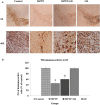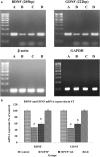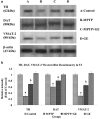Geraniol ameliorates the motor behavior and neurotrophic factors inadequacy in MPTP-induced mice model of Parkinson's disease
- PMID: 23943375
- PMCID: PMC3824202
- DOI: 10.1007/s12031-013-0074-9
Geraniol ameliorates the motor behavior and neurotrophic factors inadequacy in MPTP-induced mice model of Parkinson's disease
Abstract
Many experiments affirm the notion that augmentation of neurotrophic factors (NTFs) activity, especially brain-derived neurotrophic factors and glial cell-derived neurotrophic factors, could prevent or halt the progress of neurodegeneration in Parkinson's disease (PD). In this study, we investigated the therapeutic accomplishment of geraniol (GE 100 mg/kg) on 1-methyl-4-phenyl-1, 2, 3, 6-tetrahydropyridine (MPTP)-induced mice model of PD. Current investigation proved that pretreatment with GE ameliorates the MPTP-induced alterations in behavioral, biochemical, immunohistochemical, and immunoblotting manifestations in mice. Systematically, the loss of dopaminergic neurons and reduced NTFs mRNA expressions induced by MPTP was ameliorated to a significant extent by pretreatment with GE. We found that GE confers a potent neuroprotective agent against MPTP-induced dopaminergic denervation and may become a potential therapeutic agent for PD and/or its progression.
Conflict of interest statement
No conflict of interest
Figures







Similar articles
-
Probiotics mixture increases butyrate, and subsequently rescues the nigral dopaminergic neurons from MPTP and rotenone-induced neurotoxicity.J Nutr Biochem. 2019 Jul;69:73-86. doi: 10.1016/j.jnutbio.2019.03.021. Epub 2019 Apr 6. J Nutr Biochem. 2019. PMID: 31063918
-
Neurotrophic and neurorescue effects of Echinacoside in the subacute MPTP mouse model of Parkinson's disease.Brain Res. 2010 Jul 30;1346:224-36. doi: 10.1016/j.brainres.2010.05.018. Epub 2010 May 15. Brain Res. 2010. PMID: 20478277
-
Metformin lowers α-synuclein phosphorylation and upregulates neurotrophic factor in the MPTP mouse model of Parkinson's disease.Neuropharmacology. 2017 Oct;125:396-407. doi: 10.1016/j.neuropharm.2017.08.015. Epub 2017 Aug 12. Neuropharmacology. 2017. PMID: 28807678
-
Harpagoside attenuates MPTP/MPP⁺ induced dopaminergic neurodegeneration and movement disorder via elevating glial cell line-derived neurotrophic factor.J Neurochem. 2012 Mar;120(6):1072-83. doi: 10.1111/j.1471-4159.2011.07635.x. Epub 2012 Feb 6. J Neurochem. 2012. PMID: 22192054
-
Mechanisms of MPTP toxicity and their implications for therapy of Parkinson's disease.Med Sci Monit. 2005 Jan;11(1):RA17-23. Med Sci Monit. 2005. PMID: 15614202 Review.
Cited by
-
Three chemotypes of thyme (Thymus vulgaris L.) essential oil and their main compounds affect differently the IL-6 and TNFα cytokine secretions of BV-2 microglia by modulating the NF-κB and C/EBPβ signalling pathways.BMC Complement Med Ther. 2021 May 22;21(1):148. doi: 10.1186/s12906-021-03319-w. BMC Complement Med Ther. 2021. PMID: 34022882 Free PMC article.
-
Dietary geraniol ameliorates intestinal dysbiosis and relieves symptoms in irritable bowel syndrome patients: a pilot study.BMC Complement Altern Med. 2018 Dec 19;18(1):338. doi: 10.1186/s12906-018-2403-6. BMC Complement Altern Med. 2018. PMID: 30567535 Free PMC article. Clinical Trial.
-
Geraniol accelerates the gastric healing, minimizes ulcers recurrence, and reduces anxiolytic-like behavior in ulcerated rodents by oral or inhaled route.Inflammopharmacology. 2022 Dec;30(6):2331-2344. doi: 10.1007/s10787-022-01068-x. Epub 2022 Sep 19. Inflammopharmacology. 2022. PMID: 36121588
-
Mechanistic Insights into Ameliorating Effect of Geraniol on D-Galactose Induced Memory Impairment in Rats.Neurochem Res. 2022 Jun;47(6):1664-1678. doi: 10.1007/s11064-022-03559-3. Epub 2022 Mar 2. Neurochem Res. 2022. PMID: 35235140 Free PMC article.
-
Conjugation, Prodrug, and Co-Administration Strategies in Support of Nanotechnologies to Improve the Therapeutic Efficacy of Phytochemicals in the Central Nervous System.Pharmaceutics. 2023 May 23;15(6):1578. doi: 10.3390/pharmaceutics15061578. Pharmaceutics. 2023. PMID: 37376027 Free PMC article. Review.
References
-
- Afonso-Oramas D, Cruz-Muros I, Barroso-Chinea P, Alvarez de la Rosa D, CastroHernandez J, Salas-Hernandez J, Giraldez T, Gonzalez-Hernandez T. The dopamine transporter is differentially regulated after dopaminergic lesion. Neurobiol Dis. 2010;40:518–530. doi: 10.1016/j.nbd.2010.07.012. - DOI - PubMed
MeSH terms
Substances
LinkOut - more resources
Full Text Sources
Other Literature Sources

